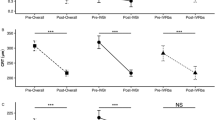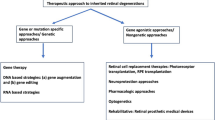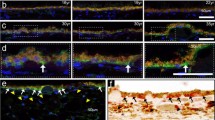Abstract
Background
Pilot study on the attempt to induce selective photoreceptor degeneration in the rabbit eye by intravitreal injection of MNU, facing the difficulties of the evaluation of retinal degeneration by different in-vivo and in-vitro methods in such a large eye animal model.
Methods
Eight pigmented Chinchilla Bastard rabbits were injected intravitreally with MNU (1 × 1mg/kg body weight (BW), 1 × 2mg/kg BW, 3 × 3mg/kg BW, 1 × 4mg/kg BW, 1 × 6mg/kg BW, and 1 × DMSO + PBS as control). One, 2, and 3 weeks after injection, the effects on the rabbit retina were examined in vivo using clinical observation (macroscopic images, funduscopy, weighing of the animals), measurement of intraocular pressure (IOP), full-field Electroretinography (ffERG), and spectral-domain Optical Coherence Tomography (sd-OCT). After 3 weeks follow-up, blood samples were taken to evaluate the general health status of the animals, and immunohistochemistry (IH) was performed on sections obtained from six different regions throughout the whole retina to evaluate MNU effects in more detail.
Results
It was difficult to observe the effects of MNU on retinal structure by OCT in vivo. Only the temporal quadrant of the retina could be visualized. Therefore, it was indispensible to evaluate the effects of MNU on the retina in vitro by examining six areas of the retina using immunohistochemistry. Furthermore, immunohistochemistry plays a decisive role to evaluate the effects on retinal cells other than photoreceptors while in H&E staining, namely the cell count of the ONL can be observed. The results obtained in vivo and in vitro in this study mainly follow the results of a previous study in mice. The low doses of MNU (1, 2 mg/kg BW) had no effects on retinal function and morphology, while high doses (4, 6 mg/kg BW) led to retinal changes in combination with significant side-effects (e.g., cataractous changes). Injection of 3 mg/kg BW MNU induced selective photoreceptor degeneration. However, the degree of degeneration varied between different parts of the same retina and between retinae of different animals. In two of three animals, a complete loss of ERG potentials was observed. Negative effects on the contralateral eye or on general welfare of the animal were never observed.
Conclusions
In rabbits, the intravitreal injection of 3 mg/kg BW MNU leads to selective but inhomogeneous photoreceptor degeneration.








Similar content being viewed by others
References
Berson EL (1993) Retinitis pigmentosa. The Friedenwald Lecture. Invest Ophthalmol Vis Sci 34:1659–1676
Gekeler F, Kobuch K, Schwahn HN, Stett A, Shinoda K, Zrenner E (2004) Subretinal electrical stimulation of the rabbit retina with acutely implanted electrode arrays. Graefes Arch Clin Exp Ophthalmol 242:587–596
Jones BW, Marc RE (2005) Retinal remodeling during retinal degeneration. Exp Eye Res 81:123–137
Menzel-Severing J, Laube T, Brockmann C, Bornfeld N, Mokwa W, Mazinani B, Walter P, Roessler G (2012) Implantation and explantation of an active epiretinal visual prosthesis: 2-year follow-up data from the EPIRET3 prospective clinical trial. Eye 26:501–509
Feucht M, Laube T, Bornfeld N, Walter P, Velikay-Parel M, Hornig R, Richard G (2005) Entwicklung einer epiretinalen Prothese zur stimulation der humanen Netzhaut. Ophthalmologe 102:688–691
Roessler G, Laube T, Brockmann C, Kirschkamp T, Mazinani B, Goertz M, Koch C, Krisch I, Sellhaus B, Trieu HK, Weis J, Bornfeld N, Röthgen H, Messner A, Mokwa W, Walter P (2009) Implantation and explantation of a wireless epiretinal retina implant device: observations during the EPIRET3 prospective clinical trial. Invest Ophthalmol Vis Sci 50:3003–3008
Wang W, Fernandez de Castro J, Vukmanic E, Zhou L, Emery D, Demarco PJ, Kaplan HJ, Dean DC (2011) Selective rod degeneration and partial cone inactivation characterize an iodoacetic acid model of swine retinal degeneration. Invest Ophthalmol Vis Sci 52:7917–7923
Rösch S, Johnen S, Mazinani B, Müller F, Pfarrer C, Walter P (2015) The effects of iodoacetic acid on the mouse retina. Graefes Arch Clin Exp Ophthalmol 253(1):25–35
Tsubura A, Yoshizawa K, Kiuchi K, Moriguchi K (2003) N-Methyl-N-nitrosourea-induced retinal degeneration in animals. Acta Histochem Cytochem 36:263–270
Rösch S, Johnen S, Mataruga A, Müller F, Pfarrer C, Walter P (2014) Selective photoreceptor degeneration by intravitreal injection of N-methyl-N-nitrosourea. Invest Ophthalmol Vis Sci 55(3):1711–1723
Schreiber D, Jänisch W, Warzok R, Tausch H (1969) Induction of brain and spinal cord tumors in rabbits with N-methyl-N-nitrosourea. Z Gesamte Exp Med 150:76–86
Durairaj C, Shah J, Senapati S, Kompella UB (2009) Prediction of vitreal half-life based on drug physicochemical properties: quantitative structure–pharmacokinetic relationships (QSPKR). Pharm Res 26(5):1236–1260
Ye YF, Gao YF, Xie HT, Wang HJ (2014) Pharmacokinetics and retinal toxicity of various doses of intravitreal triamcinolone acetonide in rabbits. Mol Vis 20:629–636
Wood D, Wood J (1975) Pharmacologic and biochemical considerations of dimethyl sulfoxide. Ann N Y Acad Sci 243:7–19
Marmor MF, Fulton AB, Holder GE, Miyake Y, Brigell M, Bach M (2009) ISCEV Standard for full-field clinical electroretinography (2008 update). Doc Ophthalmol 118:69–77
Hirota R, Kondo M, Ueno S, Sakai T, Koyasu T, Terasaki H (2012) Photoreceptor and post-photoreceptoral contributions to photopic ERG a-wave in rhodopsin P347L transgenic rabbits. Invest Ophthalmol Vis Sci 53(3):1467–1472
Cang B, Hawes NL, Hurd RE, Davisson MT, Nusinowitz S, Heckenlively JR (2002) Retinal degeneration mutants in the mouse. Vision Res 42:517–525
Chang B, Hawes NL, Pardue MT et al (2007) Two mouse retinal degenerations caused by missense mutations in the beta-subunit of rod cGMP phosphodiesterase gene. Vision Res 47:624–633
Wang S, Lu B, Lund RD (2005) Morphological changes in the Royal College of Surgeons rat retina during photoreceptor degeneration and after cell-based therapy. J Comp Neurol 491:400–417
Cuenca N, Pinilla I, Sauvé Y, Lund R (2005) Early changes in synaptic connectivity following progressive photoreceptor degeneration in RCS rats. Eur J Neurosci 22:1057–1072
Rösch S, Aretzweiler C, Müller F, Walter P (2016) Evaluation of retinal function and morphology of the pink-eyed Royal College of Surgeons (RCS) rat: a comparative study of in vivo and in vitro methods. Curr Eye Res. doi:10.1080/02713683.2016.1179333
Kinoshita J, Iwata N, Maejima T, Imaoka M, Kimotsuki T, Yasuda M (2015) N-Methyl-N-nitrosourea-induced acute alteration of retinal function and morphology in monkeys. Invest Ophathlmol Vis Sci 56(12):7146–7158
Taylor L, Arnér K, Ghosh F (2016) N-methyl-N-nitrosourea-induced neuronal cell death in a large animal model of retinal degeneration in vitro. Exp Eye Res 148:55–64
Chen YY, Liu SL, Hu DP, Xing YQ, Shen Y (2014) N-methyl-N-nitrosourea-induced retinal degeneration in mice. Exp Eye Res 121:102–113
Reisenhofer M, Balmer J, Zulliger R, Enzmann V (2015) Multiple programmed cell death pathways are involved in N-methyl-N-nitrosourea-induced photoreceptor degeneration. Graefes Arch Clin Exp Ophthalmol 253(5):721–731
Aplin FP, Luu CD, Vessey KA, Guymer RH, Shepherd RK, Fletcher EL (2014) ATP-induced photoreceptor death in a feline model of retinal degeneration. Invest Ophthalmol Vis Sci 55(12):8319–8329
Hikichi T, Ueno N, Chakrabarti B, Trempe CL (1996) Vitreous changes during ocular inflammation induced by interleukin 1 beta. Jpn J Ophthalmol 40(3):297–302
Williams DL (2007) Rabbit and rodent ophthalmology. EJCAP 17(3):242–252
Reichenbach A, Schnitzer J, Friedrich A, Ziegert W, Brückner G, Schober W (1991) Development of the rabbit retina. Anat Embryol 183:287–297
Eisner G, Bachmann E (1974) Vergleichende morphologische Spaltlampenuntersuchung des Glaskörpers von Schaf, Schwein, Hund, Affen und Kaninchen. Graefes Arch Clin Exp Ophthalmol 192:9–17
Acknowledgments
The authors thank Prof. Dr. R. Tolba and the Institute for Laboratory Animal Science of the University Hospital RWTH Aachen for the great opportunity to access one of their laboratories and to perform our experiments under special safety precautions. We further thank Jakob Becker and Detlef Emonts-Holley (University Hospital RWTH Aachen) for their support in preparing images for OCT and funduscopy. And we thank Christoph Aretzweiler (Institute of Complex Systems, Cellular Biophysics, ICS-4, Forschungszentrum Jülich GmbH) for the excellent support in the preparation of the eyes and in immunohistochemical stainings.
Author information
Authors and Affiliations
Corresponding author
Ethics declarations
Funding
The Deutsche Forschungsgemeinschaft (DFG) provided financial support in the form of research grants to PW (WA 1472/6-1) and FM (MU 3036/3-1 and 3036/2-1). The sponsor had no role in the design or conduct of this research.
Conflict of interest
All authors certify that they have no affiliations with or involvement in any organization or entity with any financial interest (such as honoraria; educational grants; participation in speakers’ bureaus; membership, employment, consultancies, stock ownership, or other equity interest; and expert testimony or patent-licensing arrangements), or non-financial interest (such as personal or professional relationships, affiliations, knowledge, or beliefs) in the subject matter or materials discussed in this manuscript.
Animal experiments
All applicable international, national, and/or institutional guidelines for the care and use of animals were followed.
Rights and permissions
About this article
Cite this article
Rösch, S., Werner, C., Müller, F. et al. Photoreceptor degeneration by intravitreal injection of N-methyl-N-nitrosourea (MNU) in rabbits: a pilot study. Graefes Arch Clin Exp Ophthalmol 255, 317–331 (2017). https://doi.org/10.1007/s00417-016-3531-7
Received:
Revised:
Accepted:
Published:
Issue Date:
DOI: https://doi.org/10.1007/s00417-016-3531-7




